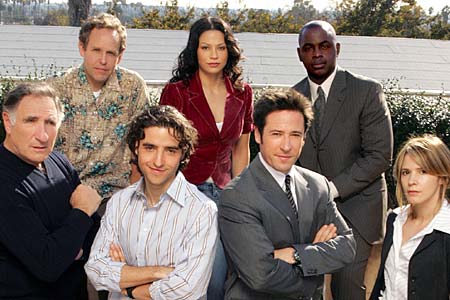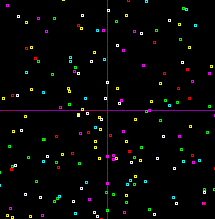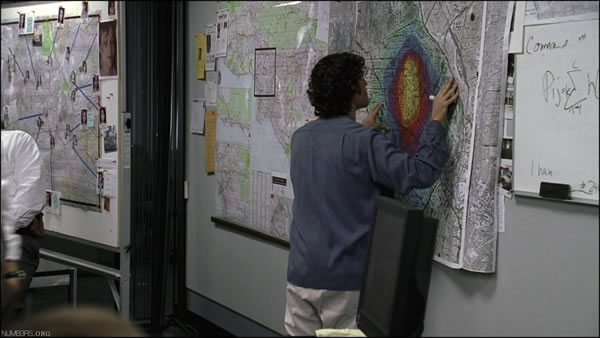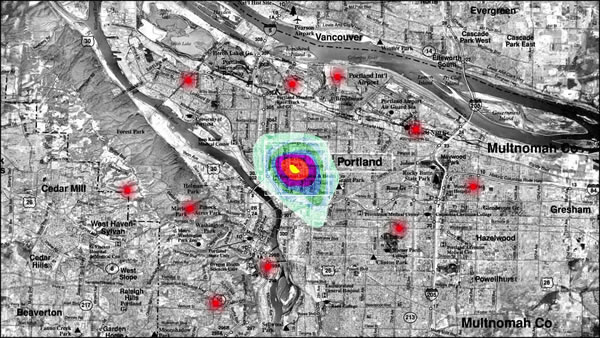

With the usual caveats and reservations about Hollywood [1], I was excited about this show [2]. I felt good about "October Skies" glorifying nerdy, geeky, science kids, but that was set in 1957. Here was a twenty–first century setting where a mathematician was going to add value in a popularly–perceived area of intellectual endeavor, solving crimes for the FBI.
Alas, the show has descended into the usual Hollywood style of mixing social, technical, and intellectual issues into a rancid soup that gives people totally wrong–headed ideas, in this case about mathematicians.
I guess now I know how psychiatrists and psychologists
feel when some TV–phrenologist working for the FBI
sees a scrap of toilet paper at the crime scene,
predicts the perpetrator's age, race, and dress style,
and then offers a complete mental diagnosis.
Let me take a moment of my reader's time
to explore what went wrong.
(I'm preparing
another page
on the social engineering aspect
of the 2005 April 29 episode
which I found particularly annoying.
This is the nice stuff.)
As I said earlier,
the "NUMB3RS" pilot was a good–humored television show
with some reasonable insights
that featured mathematics solving crime
in the person of a mathematics professor
named Charlie.
He comes in and adds considerable value
from his insights
by visualizing the problem in terms of abstraction
not available to non–mathematically–trained FBI people.
When the crime scenes are evenly spread out over a large area,
Charlie points out that distributions that look random
are not necessarily random.
He has people in the room deliberately space themselves
"randomly" and shows them that, in fact,
their almost–even spacing is quite structured.
If I could find a
place
where home computer users
could get a simple language like BASIC,
then I might have added a scene where Charlie writes
a nine–line computer program
(which would be on the screen long enough for
sufficiently–interested VCR and TiVo viewers
to stop the action and to copy it)
and shows how actual random distributions
of random dots on the screen form clumps.
The conclusion that this is one criminal makes sense
as the sequence of locations is "pseudo–random"
rather than truly random.
Score one for Charlie.
In another early episode,
Charlie analyzes disease vectors from
an apparently–deliberate infection.
He uses his mathematical insight
to determine the source of the disease
and to realize that there are two distinct spreads,
one north and one south,
from the same bus terminal.
Here I'm having a harder time believing this calculation
is beyond
USAMRID
or CDC analysts.
This is a legitimate application
of some serious mathematics,
although the math itself is not presented to the TV viewer
as it was in the pilot examples.
These are legitimate mathematical concepts
being presented to a non–technical television audience.
So why was I enthused about the "NUMB3RS" show?
And why am I so disappointed with it now?
There is an athletic intensity to what I do.
Sometimes the result is a single performance
such as
high school math contests and quiz bowls.
Other times the result is an answer
to a staggeringly–hard problem.
This intensity of effort has earned much
for my employers and clients.
The popular media ignore
the vital role system–level engineering and decision support play
in making our world run better
(or slowing its decline).
When they do show this kind of engineering,
it is in some distant place or time.
Finally, here is a television show
with decision–support mathematics in our place in our time.
Not only is the process of making scientific decisions glorified,
the people who make them are being presented as heroes.
Gosh, it's almost as exciting as the Space–Race days
when I was a venerated high–school math whiz!
In later episodes Charlie becomes
(assonance) an offensively assertive ass
when he tells a
fugitive recovery expert
where to look for a convict
with an air of authority.
In a similar situation,
I might offer the mathematical solution
as another input to the expert's thought process,
but I'm not going to tell him how to do his job!
The 2005 April 29 episode, "Sacrifice,"
annoyed
me in so many ways that
I'm writing a
separate page
to rant about it.
As the "NUMB3RS" season progressed,
the show became less insightful, less interesting,
and more of the pulp that so many television shows
have become today.
The producers and writers let me down;
shame on them!
1.
This is the same tinsel-town Hollywood
that gave us awful and unfaithful remakes of
"The Absent–Minded Professor,"
"Assault on Precinct 13,"
"Batman,"
"The Beverly Hillbillies,"
"Sgt. Bilko,"
"The Blob,"
"The Brady Bunch,"
"Charlie and the Chocolate Factory,"
"Daredevil,"
"Day of the Jackel,"
"Dudley Do-Right,"
"The Dukes of Hazard,"
"The Flintstones,"
"The Fugitive,"
"George of the Jungle,"
"Godzilla,"
"Invasion of the Body Snatchers"
"King Kong,"
"Lost in Space,"
"Mr. Magoo,"
"The Manchurian Candidate,"
"McHale's Navy,"
"Mission Impossible,"
"Mr. Bean" (bad remake of a bad TV show),
"The Mummy,"
"My Favorite Martian,"
"The Partridge Family,"
"The Pink Panther,"
"Planet of the Apes,"
"Popeye,"
"Psycho,"
"Rocky and Bullwinkle,"
"The Saint,"
"The Shadow,"
"The Shop Around the Corner,"
"The Stepford Wives,"
"Star Trek" (first and third movies),
"Starksy & Hutch,"
"The Texas Chainsaw Massacre,"
"X-Men,"
"Wild Wild West,"
et cetera.
We have seen how well Hollywood understands
computers and their programmers in
"Disclosure,"
"Hackers,"
"Jurassic Park,"
"The Matrix,"
and
"The Net."
(I'm going to spare the reader any attempt
to list awful and unfaithful sequels
or movies based on novels.)
Hollywood's movie business got started, after all,
because California didn't enforce Mr. Edison's patent rights
as vigorously as New Jersey.
It isn't a good omen, is it?
2.
In my original review of the show,
I did not take the usual math-weenie posture that
the math wasn't good enough and never would be.
I feel I met the theme of the show more than halfway.
 Along with its wit and character presentation,
the pilot presents two mathematical notions.
Not only are reasonably–correct mathematical concepts presented,
they're actually explained reasonably well
complete with flashing images that might help
and scribbled equations that are useless distractions.
Along with its wit and character presentation,
the pilot presents two mathematical notions.
Not only are reasonably–correct mathematical concepts presented,
they're actually explained reasonably well
complete with flashing images that might help
and scribbled equations that are useless distractions.
 It is natural to try to extrapolate the sequence
to figure out the next crime scene.
Watching spray from an unseen sprinkler,
Charlie realizes that the same time series
can be run backward to figure out the source,
where the criminal lives.
While I would hope real FBI people would have figured that out
without a prodigy–Ph.D. mathematician to tell them,
I'll suspend my disbelief here
and credit the show with
presenting another reasonable mathematical notion.
Score two for Charlie.
It is natural to try to extrapolate the sequence
to figure out the next crime scene.
Watching spray from an unseen sprinkler,
Charlie realizes that the same time series
can be run backward to figure out the source,
where the criminal lives.
While I would hope real FBI people would have figured that out
without a prodigy–Ph.D. mathematician to tell them,
I'll suspend my disbelief here
and credit the show with
presenting another reasonable mathematical notion.
Score two for Charlie.
 What I do is hard to explain
and most people don't want to take time to appreciate it.
As in those BASF commercials they used to show,
applied mathematicians don't make things happen,
they just make things happen
better.
What I do is hard to explain
and most people don't want to take time to appreciate it.
As in those BASF commercials they used to show,
applied mathematicians don't make things happen,
they just make things happen
better.
 The geeky mathematician coming in ex machina
and solving the crime where the experts failed
grates on me more than a little bit.
In the early episodes Charlie shows
(alliteration) comfortingly cocky competent confidence
when he says he knows where the criminal lives
from the geographic pattern of crimes.
The geeky mathematician coming in ex machina
and solving the crime where the experts failed
grates on me more than a little bit.
In the early episodes Charlie shows
(alliteration) comfortingly cocky competent confidence
when he says he knows where the criminal lives
from the geographic pattern of crimes.
 In the 2005 May 6 episode, "Noisy Edge,"
lots of folks in Los Angeles see a glowing-white aircraft
that doesn't appear on any of seven
military or civilian radar tracking systems.
Charlie analyzes the recorded radar returns
with a "squish/squash" noise-reduction algorithm
that not only tracks the aircraft their systems could not see
but forms a photographic image of the aircraft
clear enough [3]
to identify who designed it.
This is not some outside-the-box mathematical insight:
These radar systems are designed
by smart electrical engineers
for the sole purpose
of resolving locations of aircraft,
with the best noise-reduction, image-resolving power
their smartest engineers can muster.
So any squishing and squashing that can see more airplanes
would already be built into these sophisticated detection systems.
Now if Charlie had found a way to combine all seven radar returns
to find an airplane trajectory that no single system found,
then I would have found that a plausible
suspension of disbelief for a television show.
In the 2005 May 6 episode, "Noisy Edge,"
lots of folks in Los Angeles see a glowing-white aircraft
that doesn't appear on any of seven
military or civilian radar tracking systems.
Charlie analyzes the recorded radar returns
with a "squish/squash" noise-reduction algorithm
that not only tracks the aircraft their systems could not see
but forms a photographic image of the aircraft
clear enough [3]
to identify who designed it.
This is not some outside-the-box mathematical insight:
These radar systems are designed
by smart electrical engineers
for the sole purpose
of resolving locations of aircraft,
with the best noise-reduction, image-resolving power
their smartest engineers can muster.
So any squishing and squashing that can see more airplanes
would already be built into these sophisticated detection systems.
Now if Charlie had found a way to combine all seven radar returns
to find an airplane trajectory that no single system found,
then I would have found that a plausible
suspension of disbelief for a television show.
 The season finale on 2005 May 13, "Manhunt,"
has two convicts escaping from a bus
in a deliberate accident.
It doesn't take genius mathematics to tell
if a highway accident is staged
and the analysis behind it
does not involve Markov chains or Bayesian equations.
Both of these are legitimate mathematical concepts and
I could envision
television plots using them
(not necessarily good plots),
but this is sling-the-jargon Hollywood math.
When Charlie claims to know where a convict is going
more confidently than professionals
who have chased conflicts for a living for years,
I cringe at the impression viewers must be getting
of me and my work.
The season finale on 2005 May 13, "Manhunt,"
has two convicts escaping from a bus
in a deliberate accident.
It doesn't take genius mathematics to tell
if a highway accident is staged
and the analysis behind it
does not involve Markov chains or Bayesian equations.
Both of these are legitimate mathematical concepts and
I could envision
television plots using them
(not necessarily good plots),
but this is sling-the-jargon Hollywood math.
When Charlie claims to know where a convict is going
more confidently than professionals
who have chased conflicts for a living for years,
I cringe at the impression viewers must be getting
of me and my work.
15:40:03 Mountain Standard Time
(MST).
27035 visits to this web page.